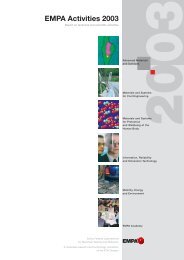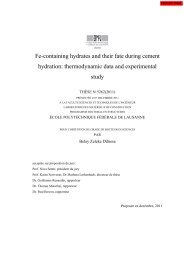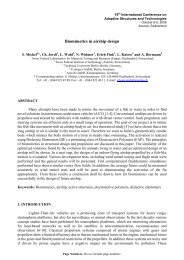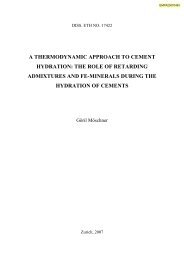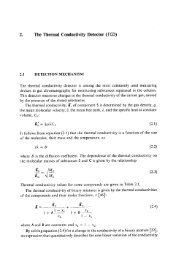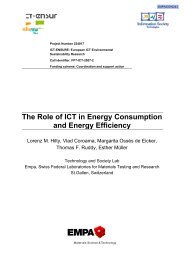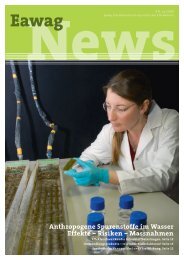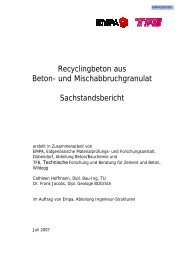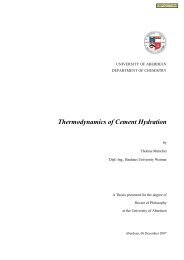Entire volume - Eawag
Entire volume - Eawag
Entire volume - Eawag
You also want an ePaper? Increase the reach of your titles
YUMPU automatically turns print PDFs into web optimized ePapers that Google loves.
emission of radiation from a sun with many<br />
sunspots is on the whole greater.<br />
This strict correlation between sunspot<br />
prevalence and irradiance measured by<br />
satellite can be seen clearly in Figure 1A + B,<br />
in which the two curves run parallel to each<br />
other. This has allowed scientists to use the<br />
number of sunspots as the basis for determining<br />
the irradiance arriving at the top of<br />
the earth’s atmosphere, and thereby map<br />
changes in climatic events over the past<br />
400 years.<br />
400 Years of Strongly<br />
Fluctuating Solar Activity<br />
If we look at the four hundred year-long<br />
sunspot record [4], they show that solar<br />
activity has fluctuated significantly more<br />
strongly and more irregularly than satellites<br />
have so far measured (Fig. 2). Practically no<br />
sunspots were recorded during the Maunder<br />
Minimum of 1645–1715, and only a few<br />
during the Dalton Minimum of 1795–1830,<br />
suggesting that the sun was relatively<br />
inactive during both periods. Since then<br />
there has been a steady increase in the<br />
number of sunspots. Lean and fellow researchers<br />
wanted more detailed informa-<br />
Sunspots<br />
200<br />
150<br />
100<br />
50<br />
0<br />
1600<br />
Fig. 2: The sunspot count since 1610 [4], given as an annual average. The more<br />
active the sun, the more sunspots appear on its surface. Along with the clear<br />
11-year cycle an increasing activity since the beginning of the 18 th century can be<br />
observed.<br />
9 EAWAG news 58<br />
Maunder Minimum<br />
Dalton Minimum<br />
1650 1700 1750 1800 1850 1900 1950 2000<br />
Year<br />
tion, and attempted to quantify the intensity<br />
of past solar radiation from the number of<br />
sunspots, concluding that irradiance has<br />
increased by 0.24% since the Maunder<br />
Minimum [2] (Fig. 3). This change is significantly<br />
outside the range of fluctuations<br />
measured to date. From observations of<br />
other solar systems, we know that stellar<br />
radiation can vary greatly – by much as<br />
1% for stars showing similar characteristics<br />
to our sun. In addition, various climatic<br />
traces on the earth indicate that such fluctuations<br />
in the irradiance are not unrealistic.<br />
For example, the occurence of the so-called<br />
Little Ice Age from about 1400 to 1850 coincident<br />
with a period of reduced solar activity.<br />
During this period, large-scale glaciers<br />
advances occured in the Alps that resulted<br />
in large moraine deposits. Furthermore,<br />
from historical sources it is known that the<br />
River Thames froze over in winter during the<br />
Little Ice Age. The ice was particularly thick<br />
in the winter of 1683/84, neatly in the middle<br />
of the Maunder Minimum! Since the winter<br />
of 1813/14, the Thames has stopped freezing<br />
over, and the glaciers have been under<br />
continuous retreat, while the number of sunspots<br />
has been increasing continuously.<br />
11,500 Years of the Sun’s<br />
Activity Recorded in the Polar<br />
Ice Cap<br />
How can we extend the historical research<br />
beyond 400 years into the past? EAWAG<br />
is currently engaged in a project with the<br />
ambitious aim of reconstructing solar activity<br />
over the entire Holocene epoch, which<br />
corresponds to the recent warm period<br />
stretching back about 11,500 years. Once<br />
again, we are dependent on indirect clues.<br />
To measure past solar activity, we are inves-<br />
Solar irradiance (W/m 2 )<br />
1369<br />
1368<br />
1367<br />
1366<br />
1365<br />
1364<br />
1600<br />
Maunder Minimum<br />
tigating the quantity of the cosmogenic<br />
radionuclide beryllium-10 ( 10Be) that was<br />
formed in the past by cosmic radiation, and<br />
which can now be found in frozen precipitation<br />
in the polar ice caps (see lead article<br />
p. 4). Thanks to this thick ice record we can<br />
go very far back in time through relatively<br />
short vertical drill-cores, since the single<br />
annual deposits have been compressed into<br />
thin layers by the pressure of the subsequent<br />
ice layers and by the ice flow. The<br />
GRIP ice core from Greenland examined by<br />
EAWAG is about 3 km long and represents<br />
several hundreds of thousands of years. In<br />
a Sisyphean undertaking, the 10Be concentration<br />
is determined painstakingly layer by<br />
layer (see article from S. Bollhalder and<br />
I. Brunner, p. 6). The 10Be concentration will<br />
enable us to determine the solar activity,<br />
provided two important points are taken into<br />
consideration:<br />
The 10 Be production does not depend on<br />
the solar activity alone, but also on fluctuations<br />
in the earth’s magnetic field. To reconstruct<br />
the solar activity, the influence of the<br />
magnetic field must also be determined.<br />
The 10 Be concentration measurable in the<br />
ice is affected not only by the 10Be produced<br />
in the atmosphere, but also by the amount<br />
of precipitation – the greater the precipitation,<br />
the more the 10Be is diluted. The measure<br />
of solar activity is therefore not simply<br />
the 10Be concentration, but rather the 10Be flux, which gives us the number of 10Be atoms deposited per square meter and<br />
second in the ice.<br />
Our investigations show that the 10Be flux,<br />
and consequently the solar activity, was<br />
very irregular over the entire Holocene<br />
epoch (Fig. 4, blue curve). A low 10Be flux<br />
indicates an active sun and a high 10Be flux<br />
1650 1700 1750 1800 1850 1900 1950 2000<br />
Year<br />
Fig. 3: Irradiance reconstructed back to 1610. The reconstruction is based on<br />
sunspot drawings and observations of stars similar to the sun. Accordingly, irradiance<br />
has increased by 0.24% since the Maunder Minimum.<br />
Adapted from [2].<br />
Dalton Minimum




